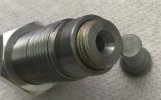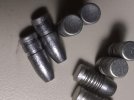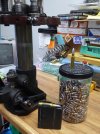glassparman
"OK, OK, I'm going as fast as I don't want to go!"
Ok so back to the 8mm Siamese project.
I ordered the Lee mold and I just happen to have a .329 Lee push through sizer.
Has anyone ever been successful seating a gas check in a push through sizer? Push in reverse? If so, how do I protect the nose from deforming?
Mike
I ordered the Lee mold and I just happen to have a .329 Lee push through sizer.
Has anyone ever been successful seating a gas check in a push through sizer? Push in reverse? If so, how do I protect the nose from deforming?
Mike



![SAECO264_6-5mm140gGC-9[1].jpg SAECO264_6-5mm140gGC-9[1].jpg](https://www.artfulbullet.com/data/attachments/35/35140-95e3b6daa638bc9252306306c2bc237c.jpg)
